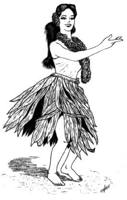
|
Folk Dance Federation of California, South, Inc.
|

|
CLICK AN IMAGE TO ENLARGE
Kāholo (vamp): Moving to the right, step, together, step, Pa (touch ball of foot to floor). Moving to the left, repeat.
ʻAmi: A circular movement of the thighs, hips and waist in a counter-clock (right) or clock-wise (left) direction beginning on the right side for right ʻami and left side for left ʻami and always ending with the hip at the back. (In all the ʻami definitions that I have, it says a circular motion, but I was taught differently, and I think Chinky also says it this way: The hips move circular in front (right to left, or left to right), but straight across in back... in other words, hips don't stick out in back.)
ʻAmi kuku: Two slow ami followed by three fast ʻami.
Kaʻo: Sway by placing weight on opposite balls of the feet and simultaneously lifting the hip of the unweighted side of the body. Upper body, chest should be held steady, relaxed and not moved.
Kalākaua: Step forwward on right with weight, step in place with left, step backward on right with weight, step in place with left (repeat).
ʻO Single: step, step, step, Pa.
Kawelu Double: step, step, step, step, step, step, step, Pa.
Hela: One foot is placed on about a 45 degree angle to the front. The foot is then returned to the original position and the step is repeated with the other foot. (Knees bent.)
Oniu: Figure eight motion of the hips.
Oniu Kuku: Two slow figure eights, followd by three fast figure eights.
Huki: Step forward right, pull left foot off floor near right angle. The huki is the step often used by men in both ʻAuana and Kahiko (modern and ancient). Seldom used by women, in Kahiko. There is a "snap" to the feet as the left foot comes in front, and the left foot, with men, may go completely across the right foot, and sometimes rather high.
Ako Pua: Face front, right foot goes in front, out to right, side, front, side, return to position and shift weight.
Ako Pua Kuku: Eight counts to each side, twisting heal and toe to travel.
Kālholo: Step, together, step, together, step together, step, Pa.
Heʻeia: Right foot front, side, then Kālholo right.
Uwehe: Feet together, and quickly flex the knees and thighs at a 45 degree angle.
Uweke (sides): Angle away from the body. The knees are bent to prevent the upper body from bouncing.
Ula Noweo: Step right, brush forward with left and back, then Uwehe.
ʻŌlapa: Point side, then front, then Uwehe.
Welina: Place right toe 12 o'clock then 2 o'clock, then lift right foot simultaneously pivoting the ball of the left foot inward and place the right foot down on the floor to begin opposite motion of the left side.
Lele: This is a walking step, or traveling Kaʻo.
Lele ʻUwehe: For Right: step R foot, point L foot, bring L foot in and Uwehe. For Left: step L foot, point R foot, bring R foot in and Uwehe.
Hulilau: Moving the same as Kāholo except eight counts in same direction.
Kaʻapuni: The dancer twirls around in a circle on the ball of one foot while the other foot takes steps to complete the the turn (referred to as "Around the Island").
Kiʻi waiwai: Point foot side, front, together, and Uwehe.
Sources: State Council on Hawaiian Heritage, Hoakalei Kamauʻu,
and the Pukui-elbert Hawaiian Dictionary.